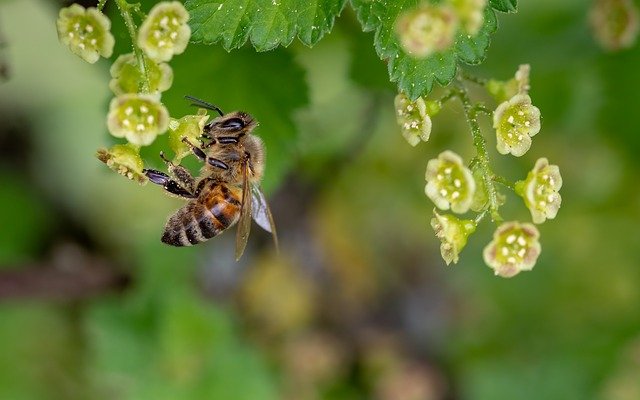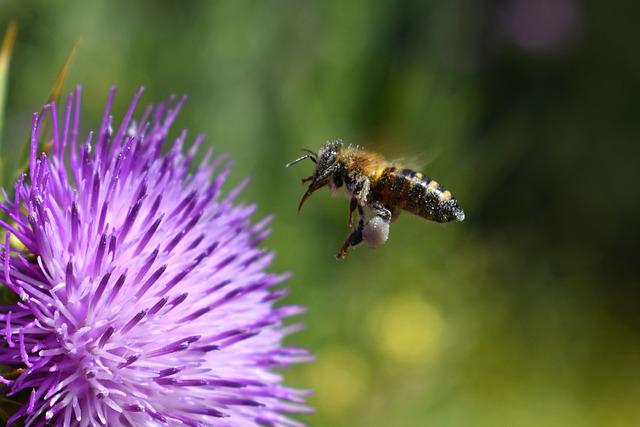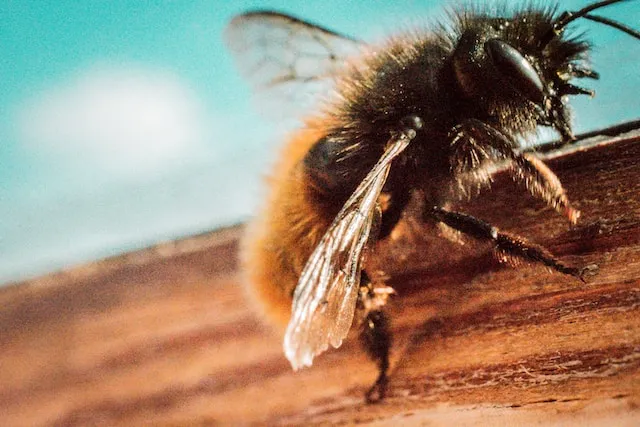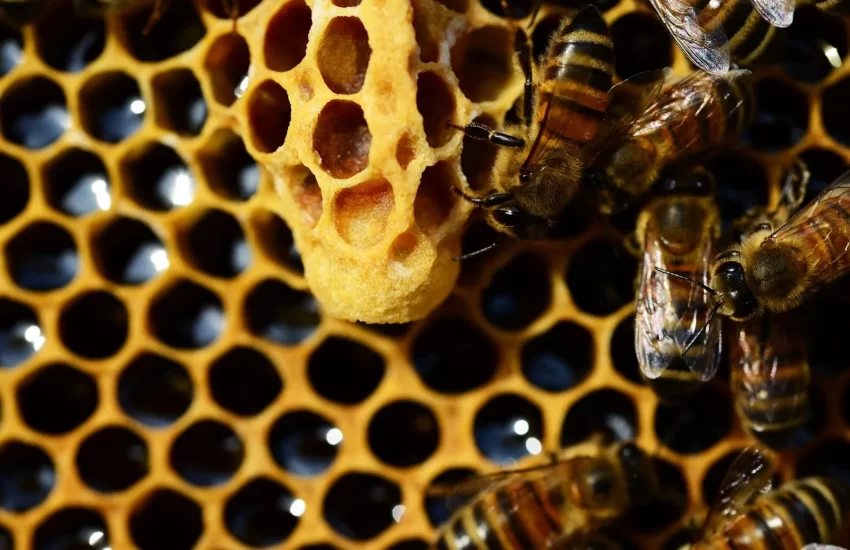How far do honey bees travel from the hive?
Honey bees travel away from their nest to forage for pollen and nectar from blooming flowers for their colonies. As a beekeeper, close proximity to the food sources should be one of the considerations as you are setting up an apiary. You may have to feed the bees if a nectar flow is missing in the region.
How far do honey bees travel from the hive?
Honey bees can fly 3-5 miles from their hive in any direction. Worker bees are able to go for more foraging flights when food resources are near. This means that more food is collected in a given time for the colony. They also prefer to fly to rich, easy-to-collect food resources far from poor food resources. They fly for about 500 miles in a lifetime before their wings get worn out, and their health depreciates. The drones and the queen also travel away from the hive to mate as far as 5-6 miles from the nest.
Similar Articles you may like to read –
What colors should you avoid around bees?
What Color Bees Cannot Recognize?
Approximately how many flowers must bees visit to produce one pound of honey?
Do Bees Like The Full Sun?
Do Bees Recognize Their Owners?
What is the ideal temperature for the bees to fly?
Honey bees usually fly when the temperatures are between 13 and 37 degrees centigrade. They only commit to foraging at temperatures of about 19 degrees. They stop flying when the temperature gets below 10 degrees. Bees will also avoid flying in the rain since it will weigh them down by making the wings heavy. Large raindrops may also damage the wings. Amazingly, they can predict the weather better than human beings. They are also able to predict a storm and its severity as well. When the weather is cold, they do not fly more than 50 meters away from the hive to seek food sources. They are also affected by high winds, low light intensity, and rain.
How a Honey Bee Fly
The honey bee has two sets of wings: the forewings and the hind wings, which are hinged to the thorax. The wings consist of 3 layers: a transparent membrane on top and bottom, nerves, and breathing tubes. Hairs cover the outer surfaces both above and below. It is incredible how a bee flies to such long distances with tiny wings compared to its weight. They seem to defy the mathematics laws that show their wings cannot provide enough lift for their big bodies off the ground.
Besides moving up and down, the honey bee moves its wings in a rotating manner making sweeping motions from front to the back. It makes short and fast strokes of the wings flapping together, which gives the bees enough lift capacity to fly. Surprisingly they can flap their wings up to 230 times in a second. The fast-beating wings create air vibrations creating a buzz. This also makes the buzzing sound when not in flight. The smaller the bee, the faster the wing beats, and the higher the pitch that results in a buzz. The bees hook and unhook the wings, which enables them to lay flat against their bodies in the hive.
The muscles in the thorax are specialized to allow the wings to move very fast in two directions: up -and -down and left and right. Amazingly a honey bee can twist the wings forward and aft, rest them over her back, move one over the other, or move them out and perpendicularly to the abdomen. Bees also use their wings when they are stationary. They flap their wings to circulate air throughout the hive to regulate its temperature, dehydrate honey, and spread pheromones throughout the hive.
Distance Bees Travel for Food
Bees are great travelers when it comes to finding food. They usually fly about 1 to 2 miles away from their hive to look for flowers full of nectar and pollen. Sometimes, they’ll even go up to 5 miles or more if they need to. This long-distance journey helps them discover lots of different flowers to collect food from. By traveling far and wide, bees make sure there’s always enough food to keep their hive strong and busy all year round.
Distance Bees Travel to A Pollen Source
When bees go out to collect pollen, they can fly quite a distance to find the best flowers. Usually, they travel around 0.5 to 2 miles from their hive to reach a good pollen source. But sometimes, they might need to go even farther, up to 5 miles! This long journey helps them find lots of flowers with plenty of pollen to bring back to the hive. By searching far and wide, bees make sure there’s enough pollen to feed their colony and keep it healthy. Plus, their travels help pollinate plants, which is super important for gardens and farms.
How Far Bees Fly for Water
Bees need water to stay alive, just like we do. But they don’t have to travel as far for water as they do for food. Usually, bees will fly about 100 to 200 yards from their hive to find water. They might look for water in puddles, ponds, or even in bird baths. If they can’t find water nearby, they might go as far as a mile or more. Bringing water back to the hive helps keep the inside cool and humid, especially when it’s hot outside. So, while it’s not as far as their food trips, finding water is still really important for bees.
How do bees find their way back home?
Bees are excellent when it comes to finding their way back home. They navigate their way back to the hive by memorizing critical landmarks in their environment. To master, they observe the visual cues and allow them to orient themselves in different local environments. The landmarks can be trees, buildings, or other artificial objects. They also use an internal map to establish where they are in an environment. They determine their orientation relative to the sun. Amazingly, they can measure the time of the day from the sun’s position.
How many foraging trips can a bee make in a single day?
The number of trips depends on forage availability, weather, and the strength of a colony. A worker bee can make 5-15 trips. On hot days a colony also collects water to cool the nest. In fact, on such days, they focus more on getting water than pollen and nectar. Water collectors can make up to 100 trips in a day.
Foraging Fidelity and its Effect on Pollination

Foraging bees are known to limit their field visits to single plant species. This is significant in pollination success since it enhances the transfer of pollen in the same plant species. However, in places with major floral diversity and few plantings, foraging bees will visit various plants in a single trip. This results in mixed pollen loads of foraging bees returning to the hive.
FAQs
At what speed do honey bees fly?
A healthy adult worker bee will fly at around 15-20 mph (21-28km/h) while leaving the hive, but this speed will reduce to 12mph(17km/h) once they are loaded with nectar, pollen, or water. Amazingly, they can carry a load of as much as their body mass.
More articles you may like to read –
Do Male Bees Die After Mating? Honey Bee Mating Behavior
What Happens When a Queen Bee Dies?
How long do queen bees live?
How quickly do bees multiply? Reproduction of Honey Bees
Are queen bees born or made?
What happens to the bees when they continuously forage at longer distances?
When bees forage at extreme distances from the hive, their wings wear out, the life expectancy of the foraging bees is significantly reduced, and the efficiency of a colony is reduced. The flight distance is a high cost in terms of time and energy for a worker bee.
How far do bees fly to collect water?
Like pollen and nectar, bees can travel up to 5 miles to get a good water source. They need a lot of water to survive, especially in hot weather. That is why beekeepers should provide a clean water source near the hive.
You might be interested in our article ” 30 Best Flowers That Attract Bees, Butterflies, and Pollinators to Garden “



